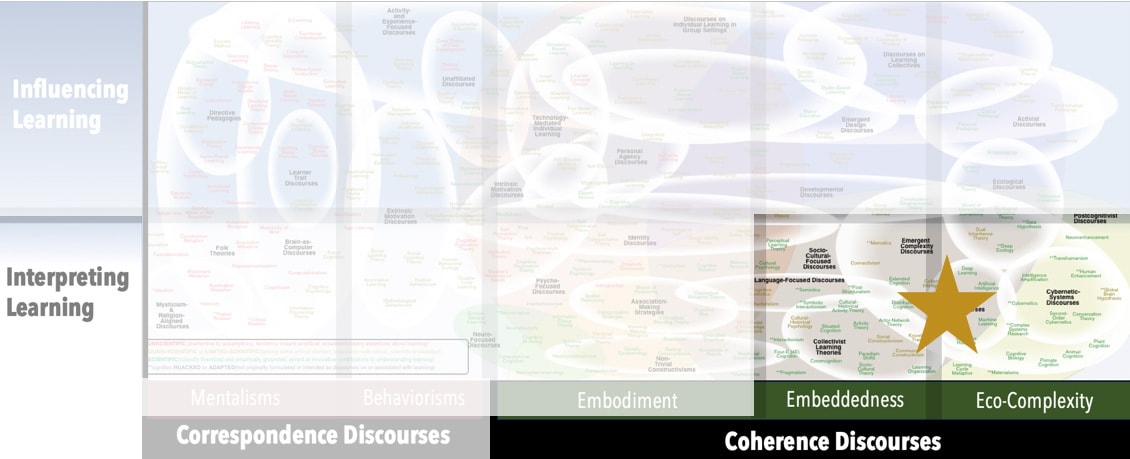AKA
Biocultural Evolution
Gene–Culture Coevolution
Focus
Co-evolution of genetics and culturePrincipal Metaphors
- Knowledge is … scope of manifest possibility
- Knowing is … viable activity
- Learner is … evolving agent (individual, social, cultural)
- Learning is … replicating patterns, copying
- Teaching is … manifesting, modeling
Originated
1960sSynopsis
Dual Inheritance Theory aims to explain human activity in terms of two intertwined processes: biological evolution and cultural evolution. Concisely, changes at the genetic level can influence culture, and changes in culture can influence genetic selection. Associated discourses include:- Anthropogenic Evolution (2020s) – either (1) biocultural evolution of the human species as influenced by human-caused changes to the more-than-human world, or (2) biological evolution of other species as influenced by human-caused changes to the environment
- Population Dynamics – the disciplined analysis of the evolutions of a population over time – that is, of the how’s and why’s of population change
- Repeated Learning (P. Strimling, 2000s) – Contrasted with Population Learning (see above), by which one acquires a trait/information by virtue of being a member of a species (that is, such learning/evolution occurs only once, at the level of the species), Repeated Learning applies to the learning of an aspect of culture, which must be learned repeatedly (that is, it must be learned by each member of the culture individually).
- Social Brain Hypothesis (Machiavellian Intelligence Hypothesis) (Frans de Wall, 1980s) – the suggestion that aspects of social life (e.g., the demands on perception and memory that are necessary to function effective in large social groups) are the primary influences on the evolution of the human brain and the emergence of intelligent behavior
- Social Evolution – subdiscipline of both evolutionary biology and sociology, focused on social behaviors and the evolution of social systems
- Sociocultural Evolution (Cultural Evolution; Sociocultural Evolutionism; Sociogenesis) — theories describing how societies and cultures change over time
Commentary
Criticisms of Dual Inheritance Theory have tended to be developed around concern that the association between biological evolution and cultural evolution may be, at best, an analogy – whereas proponents of the theory tend to treat it as literal. See Universal Darwinism for additional commentary.Authors and/or Prominent Influences
Richard Dawkins; E.O. WilsonStatus as a Theory of Learning
Dual Inheritance Theory can be construed as an attempt to make sense of the co-entanglement of two learning systems.Status as a Theory of Teaching
Dual Inheritance Theory is not a theory of teaching, but proponents make frequent references to the role of teaching in cultural evolution.Status as a Scientific Theory
No systematic program of research has arisen around Dual Inheritance Theory, no doubt in part due to huge methodological complexities associated with making sense of cultural and biological dynamics simultaneously. These systems operate in very different physical and temporal scales. As well, considerable criticism has been leveled against some orienting assumptions, especially around efforts to generalize or transpose principles based on one domain of evolution onto another.Subdiscourses:
- Anthropogenic Evolution
- Population Dynamics
- Repeated Learning
- Social Brain Hypothesis (Machiavellian Intelligence Hypothesis)
- Social Evolution
- Sociocultural Evolution (Cultural Evolution; Sociocultural Evolutionism; Sociogenesis)
Map Location

Please cite this article as:
Davis, B., & Francis, K. (2024). “Dual Inheritance Theory” in Discourses on Learning in Education. https://learningdiscourses.com.
⇦ Back to Map
⇦ Back to List
